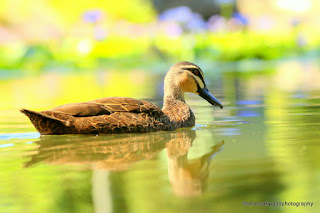Despite being predominantly brown, the Pacific Black Duck has always been known as the ‘black duck’. Its only black plumage is a bold stripe that runs across the bird’s face, from its bill to behind its eye, giving it a distinctively striking pattern. It has been claimed that the duck appears as though it is black when seen at a distance. The species is known as the ‘Grey Duck’ in New Zealand, but as it has barely any grey plumage, this is hardly a more appropriate name! Description The Pacific Black Duck is mostly mid-brown in colour, with each feather edged buff. The head pattern is characteristic, with a dark brown line through the eye, bordered with cream above and below and a dark brown crown. The upper wing colour is the same as the back, with a bright glossy green patch in the secondary flight feathers. The white underwing is conspicuous in flight. Young Pacific Black Ducks are similar to the adults in plumage. Distribution The Pacific Black Duck is found in all but ...
 The Australian White Ibis is identified by its almost entirely white body plumage and black head and neck. The head is featherless and its black bill is long and down-curved. During the breeding season the small patch of skin on the under-surface of the wing changes from dull pink to dark scarlet. Adult birds have a tuft of cream plumes on the base of the neck. Females differ from males by being slightly smaller, with shorter bills. Young birds are similar to adults, but have the neck covered with black feathers. In flight, flocks of Australian White Ibis form distinctive V-shaped flight patterns. Another common name for this bird is Sacred Ibis, but this more appropriately refers to a closely related African species.
The Australian White Ibis is identified by its almost entirely white body plumage and black head and neck. The head is featherless and its black bill is long and down-curved. During the breeding season the small patch of skin on the under-surface of the wing changes from dull pink to dark scarlet. Adult birds have a tuft of cream plumes on the base of the neck. Females differ from males by being slightly smaller, with shorter bills. Young birds are similar to adults, but have the neck covered with black feathers. In flight, flocks of Australian White Ibis form distinctive V-shaped flight patterns. Another common name for this bird is Sacred Ibis, but this more appropriately refers to a closely related African species.




Comments
Post a Comment